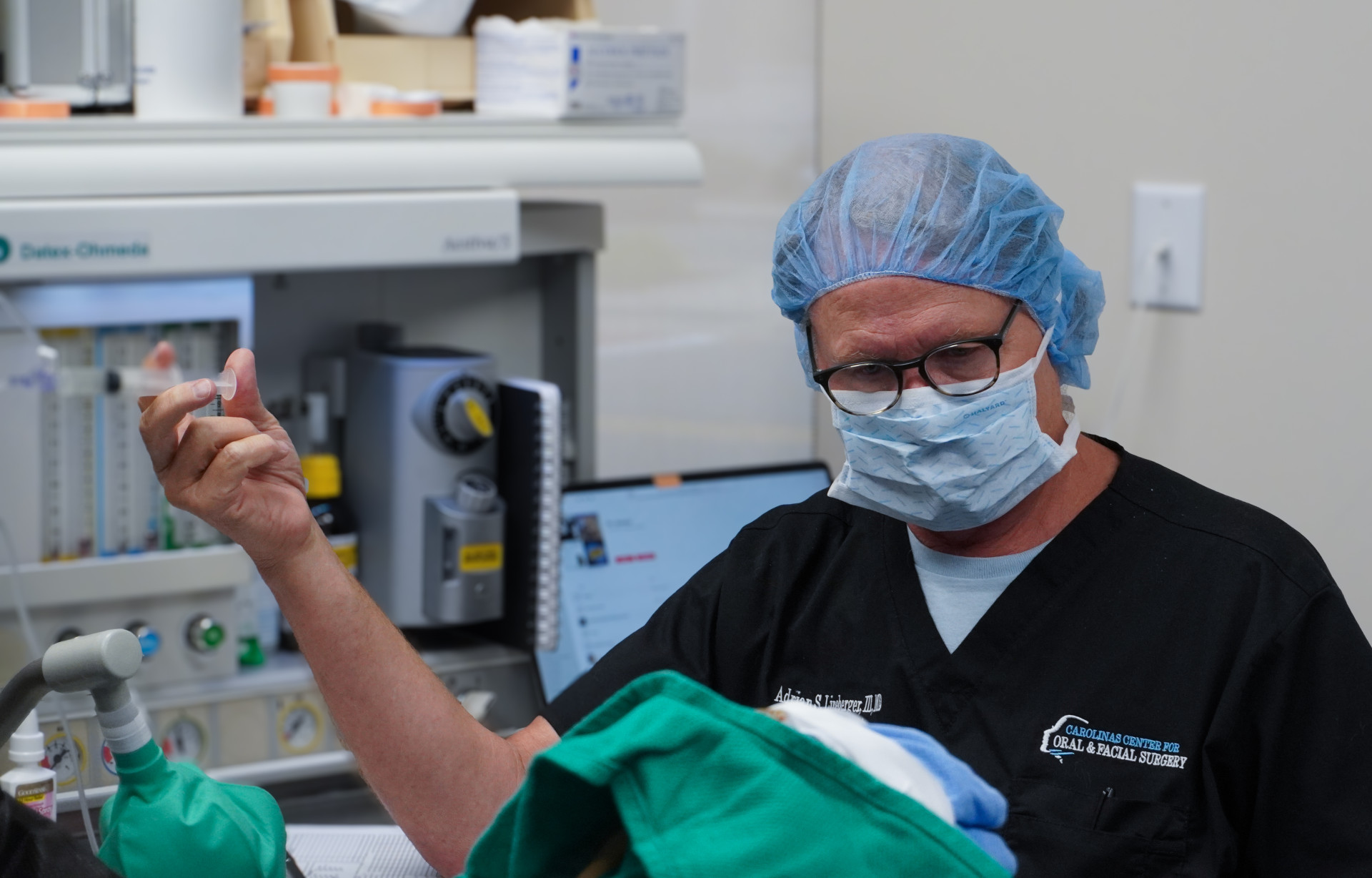- Our Services
- Anesthesia
- Bone Grafting
- Cleft Lip, Palate & Craniofacial Surgery
- Corrective Jaw Surgery
- Dental Implants
- Facial & Cosmetic Reconstructive Surgery
- Facial Trauma
- Full Arch Restoration
- Impacted Canines
- Oral Pathology
- Sleep Apnea Treatment
- Tooth Extractions
- TMJ Disorder
- Wisdom Teeth Removal
- Zygomatic Implants

Your Comfort Matters
We offer several anesthesia options to help you feel comfortable and safe during surgery. Whether it’s local anesthesia or IV sedation, the Carolinas Centers for Oral & Facial Surgery team will ensure that everything goes smoothly for you before, during, and after the procedure itself. We’ll work together to figure out which treatment would be the best fit for your needs.
There are three main choices for anesthesia
Local Anesthesia
Local anesthesia provides numbness directly where it is administered. It does not affect consciousness, so the patient remains awake while the feelings of discomfort are eliminated. Local anesthesia is commonly used for minor procedures.
Nitrous Oxide
Also known as laughing gas, nitrous oxide is a mild sedative that the patient inhales to alleviate feelings of anxiety. It does not cause the patient to lose consciousness. It is often used together with local anesthesia.
IV Sedation
IV sedation is commonly used for moderate to extensive oral or facial surgery procedures. This type of sedation is administered directly into the patient’s vein. Since amnesia (forgetfulness) is a common side effect of the medication, most patients who use IV sedation do not remember their procedure.
Learn More About Anesthesia
The right type of anesthesia can make a difference in your dental experience. To help you decide which is best for your treatment plan, please contact our friendly team, and we’ll be happy to answer any questions or concerns that come up along the way!
Oral Surgery Anesthesia Options
Whenever a patient undergoes surgery, a trained medical professional prescribes the appropriate method of anesthesia to minimize their pain and discomfort. This is true for general surgery and oral-maxillofacial procedures. Whether you are undergoing corrective jaw surgery, wisdom tooth extraction, or dental implantation, your oral health team will administer safe and effective anesthesia to ensure patient safety and peace of mind.
Anesthesia Options
The kind of anesthesia recommended by your doctor will depend on the kind of procedure being performed, as well as your level of comfort. In general, the three main types of anesthesia commonly prescribed for oral-maxillofacial surgeries are:
Local Anesthesia: For minor procedures on soft tissue and simple tooth extractions, your OMS may only administer anesthetic to the area being operated on. In this case, the patient will experience numbness in the localized area but will remain conscious throughout the procedure.
Nitrous Oxide: For both simple and more complicated procedures – such as wisdom tooth extraction – an OMS may administer a combination of nitrous oxide and oxygen to the patient through a breathing mask. Combined with a local anesthetic, the effect of this “laughing gas” is to relax the patient while remaining conscious. The amount of sedation under nitrous oxide can be easily adjusted and there is no “hangover” aftereffect, making it a popular method for many procedures.
General Anesthesia: Used for serious procedures, as well as for more minor procedures per the patient’s preference. Sedatives are administered via an IV so that patients are completely unconscious during the procedure. Vital signs are closely monitored, and oxygen is administered. Patients who undergo general anesthesia typically remain unconscious and have no memory after their surgery. It is recommended that patients fast prior to general anesthesia.
The precise type of anesthesia being used depends on the procedure's seriousness, but also on the patient's anxiety levels and pain tolerance. This is up to patient discretion and doctor recommendation, and the circumstances may vary from case to case. In most cases, an OMS is fully qualified to prescribe and administer anesthesia to a patient. As always, however, patient safety and comfort are paramount. For that reason, more serious procedures may require the intervention of an anesthesiologist in the OR.
OMS vs. Anesthesiologist
As part of their extensive training in dentistry, internal medicine, and surgery, oral-maxillofacial surgeons are also rigorously trained in anesthesia. This includes observing anesthetic procedures, administering different kinds of sedatives, and monitoring patients before and after procedures. All this training makes your average OMS well-versed in the use of anesthesia. In fact, according to the Delaware Journal of Public Health, a whopping 78% of anesthetic procedures between 2018 and 2021 were performed by an OMS.
All this being said, there are cases in which the safety of the patient – and the judgment of the OMS – means that the procedure needs to be performed by an anesthesiologist in the OR. This is often the case for more serious procedures such as reconstructive jaw surgery and TMJ surgery. It is also common when a patient has a serious health condition like heart or lung disease. In these cases, although an OMS may be perfectly qualified, general anesthesia will be administered by an anesthesiologist in the OR.
Anesthesia is one of the great advancements of modern medicine, allowing surgeons to work uninterrupted while patients have a relaxing, pain-free experience. It is recommended for many procedures to different degrees and can often be tailored to a patient’s specific comfort level. As always, to maximize safety, patients should follow exactly the instructions of their doctor – including fasting before general anesthesia and enlisting a friend to drive them home after the procedure. The extensive training undergone by an OMS prepares them for the majority of anesthetic procedures; but to prioritize the well-being of patients and adapt to their specific needs, the intervention of an anesthesiologist is always a possibility.





